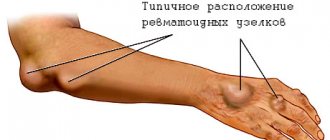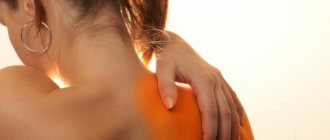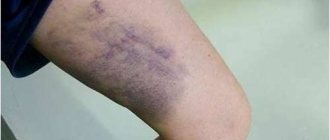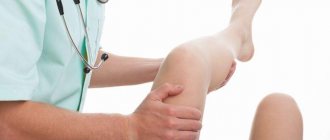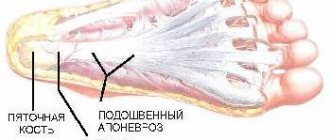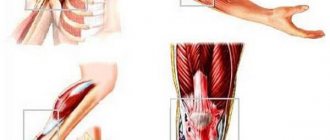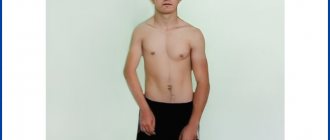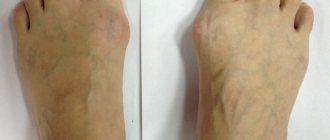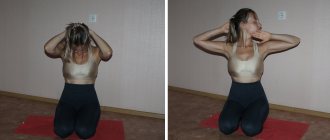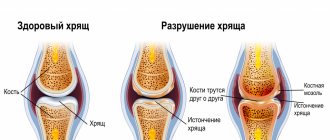At any time of the year, people are faced with a common problem, which is popularly called a cold in the neck. The medical name for this problem is cervical myositis, which means acute inflammation of the skeletal muscles. You can get this disease by sitting in a draft, with an open window in a car, or under an air conditioner. The next morning after such seemingly harmless effects, it is impossible to lift your head from the pillow due to acute pain in the cervical spine.
The manifestation of such pain is in no way related to the age and gender of a person, while in children the course of the disease can progress with the manifestation of more serious symptoms and further consequences.
Cases where several muscles are affected by inflammation are called polymyositis.
Myositis is divided into acute and chronic, and one follows from the second.
Myositis of the cervical spine causes acute and severe pain, which intensifies significantly when moving the head. Pain occurs because inflamed muscles begin to put pressure on the nerve endings.
Causes
Let's consider the main reasons for which myositis of the cervical muscles occurs:
- A draft, when blowing through the neck muscles, causes symptoms of neck myositis the next morning.
- Hypothermia, which occurs when a person dresses inappropriately for the weather, ignoring a hat and scarf. Often this disease occurs when a person, warmed up after physical exertion, goes outside or sits under the air conditioner.
- Consequences of infectious diseases such as ARVI, tonsillitis and tonsillitis. It can also be a consequence of rheumatism.
- The culprits of muscle inflammation can be diseases of the cervical spine: osteochondrosis, intervertebral hernia and arthrosis, under the influence of which the normal arrangement of the vertebrae changes and, as a result, the location of nearby soft tissues. In this case, the muscles are constantly in a tense state, trying to ensure the normal position of the spine. Under these conditions, the neck muscles can become inflamed and stretched.
- Post-traumatic myositis appears in the event of injury, for example, during sports, when the muscles experience maximum stress.
- This disease is a faithful companion of many professions: musicians, office workers and students, due to being in an uncomfortable and incorrect position for a long time.
- Some experts associate the manifestations of this disease with exposure to prolonged stress.
- Parasites that live in muscles.
- Intoxication of the body due to poisoning with alcohol, medications and narcotic drugs. The situation becomes more complicated if metabolic problems such as diabetes or gout are added to the listed reasons.
It is important that different types of myositis have different causes:
- Neuromyositis is not only an inflammation of the neck muscle, but also an inflammation of the nerve endings, and in advanced cases leads to degenerative changes.
- Purulent myositis - when infectious pathogens enter an open wound: staphylococci and streptococci. Infection can also occur during surgery.
- Infectious - characteristic of the acute period of an infectious disease, for example, ARVI and rheumatism.
- Myositis ossificans is the accumulation of calcium salts in the muscles; such accumulation occurs after injury and can also be congenital.
Diagnostics
The first thing to do if a lymph node is inflamed is to visit a doctor. He will inspect not only the disturbing group, but also the neighboring ones. It’s easy to miss this on your own, but detecting such changes will help make a diagnosis. If several lymph nodes are affected, the mucous membranes and skin are also examined for rashes.
The phased examination includes:
- General and biochemical blood test, general urine test.
- Testing for hepatitis B and C, HIV, syphilis.
- Fluorography, if necessary, an x-ray of the lungs.
- Ultrasound of the abdominal organs.
- Ultrasound of lymph nodes.
- Biopsy of lymph node tissue.
Based on the research results, a diagnosis is made and treatment tactics are formulated.
Symptoms
Myositis of the neck muscles in acute form progresses quickly, in contrast to the symptoms of osteochondrosis, which manifest themselves mainly during physical exertion. Such distinctive symptoms are important when making a diagnosis and choosing a treatment method.
Let's look at the symptoms characteristic of neck myositis:
- The pain is intense, which intensifies significantly with any head movements. By palpation, you can feel the nodules of the inflamed muscle and evaluate the affected area. With such pain, a person instinctively begins to look for a body position in which the pain will subside. The pain can spread to the muscles of the entire shoulder girdle. A characteristic symptom is the presence of pain on only one side.
- In cases where a person has a cold in the neck, the symptoms manifest themselves in the form of tension not only in the neck muscles, but also in the neighboring muscles. The range of motion is reduced and stiffness appears.
- The muscles swell, the inflamed area can be identified by the appearance of swelling.
- With an increase in body temperature, redness of the skin and increased pain are symptoms of purulent myositis, which may be accompanied by fever and headache. And symptoms of intoxication of the body also appear.
- Headache appears in the back of the head and temples in the form of throbbing pain. Difficulties with eating may occur due to tension in the masticatory muscle.
- Chronic myositis is characterized by night pain, which intensifies when weather conditions change. In cases of prolonged illness and lack of treatment, this can lead to atrophy of the neck muscles.
- Cough, shortness of breath and difficulty swallowing are symptoms of a severe form of the disease. Under such conditions, inflammation spreads to neighboring muscles: the esophagus, larynx, causing disruptions in their work.
- The appearance of small purple rashes and rashes indicates dermatomyositis of the cervical spine. Accompanied by swelling of the eyelids and lips.
- Parasitic myositis is accompanied by an increase in body temperature and the appearance of increasing pain associated with an increase in the number of parasites (Trichinella) in the muscle fibers.
Symptoms of pathology
The fact that a person has “caught” a lymph node usually means its increase in size. Occasionally it hurts, and the skin over it becomes red. In this case, doctors talk about lymphadenitis.
An important point is the mobility of the lymph node. Normally, it easily moves a short distance. If the lymph node is motionless and enlarged, a doctor’s consultation is urgently needed.
Not all lymph nodes can be examined independently. When magnified, they can be felt on the neck, under the armpits, and in the groin area. It is important where the inflamed area is located. If a lymph node in the neck has caught a cold, how to treat it will differ from the situation when the groin or axillary area is affected. By localization, one can judge a preliminary diagnosis, since lymphadenopathy is often only a symptom of the underlying disease.
Myositis in a child
Cervical myositis in a child is a fairly common occurrence, which appears mainly due to hypothermia. The main problem is to determine when a child has a cold in the neck; this is especially true at a young age, when he cannot yet complain of pain in the neck. At this age, you need to carefully monitor the child’s behavior, so in cases where the child has a cold neck, limited head movements appear, and the child reacts to pain by crying.
In addition to a draft, the reason may be an incorrectly selected pillow (in height and hardness) and mattress, that is, incorrect body position during sleep.
If there is a suspicion of neck myositis in a child, you should consult a doctor and not self-medicate. The peculiarity of the course of such a disease in children is the possibility of transition to an acute form with rather unpleasant consequences for a small and fragile organism.
You need to know that the drug treatment plan for adults does not always coincide with children's treatment in terms of dosage and types of drugs, and folk remedies should be used only after consultation with a doctor.
Therefore, no matter how ordinary the phrase “a child has a cold neck” might sound, you should not let the disease take its course, you must contact a medical institution.
Treatment
If a patient has a cold lymph node, treatment is selected taking into account the underlying disease. The treatment regimen depends on the type of pathogen.
Treatment methods:
- Antibiotic therapy - for bacterial infection.
- Antiretroviral drugs - for HIV and AIDS.
- Antiherpetic drugs - for herpetic infection.
- Antimycotics - for fungal infections.
- Bed rest and plenty of warm drinks - for mild ARVI.
Self-medication is dangerous not only due to the incorrect selection of drugs, but also the development of the underlying disease. It is better to detect it early and treat it than to waste time and money on inappropriate medications.
Read also: Dry paroxysmal cough
Dear patients! Remember that only a qualified doctor can make an accurate diagnosis, determine the causes and nature of the disease, and prescribe effective treatment. You can make an appointment with our specialists or call a doctor at home by calling 8-(4822)-33-00-33
Be healthy and happy!
What to do if you have a cold in your neck
Treatment of neck myositis should have an integrated approach.
First of all, it is necessary to ensure peace and home routine. Next, the treatment plan focuses on taking topical medications that act directly on the inflamed areas of the body.
Non-steroidal anti-inflammatory and painkillers - prescribed to relieve inflammation and pain. In cases where the disease is accompanied by fever, swelling and severe pain, NSAIDs made in the form of injections are used:
- Diclofenac.
- Meloxicam.
- Ketoprofen.
There are dual-action agents that eliminate both pain and inflammation and act as an antipyretic:
- panoxen and dolaren - includes the active ingredient - diclofenac plus paracetamol;
- next - active ingredient - ibuprofen with the addition of paracetamol.
To treat neck myositis, ointments and creams with a warming effect are used, which reduce pain and increase blood flow. Myositis of the neck muscles causes muscle spasm and tension. In such cases, use products with snake venom:
- Viprosal;
- Apizartron;
- Vipratox.
To relieve the inflammatory process and eliminate pain, fastum gel and dolobene ointment have proven themselves well.
You need to know that the use of ointments with a warming effect has contraindications. Such drugs are not used in cases of purulent myositis, as they will only intensify the course of the disease.
When the disease is purulent, antibacterial agents are used, for example, penicillin, combining them with antipyretics.
Neck myositis should be treated with such remedies in cases of inflammation caused by hypothermia and muscle tension.
Drugs with local effects sometimes cause allergic reactions. To avoid such a reaction, you can apply the ointment to a small area of skin and wait 15–20 minutes. In the absence of an allergic reaction, it can be applied to the affected muscle and to enhance the warming effect, you can wrap yourself in a scarf or shawl.
What diseases does it occur in?
First, you need to look for inflammation near the affected lymph node. Usually bacteria or viruses enter it from a nearby organ.
Diseases in which the cervical lymph node becomes inflamed:
- acute respiratory infections and acute respiratory viral infections;
- tonsillitis (acute or chronic);
- dental diseases (focus of infection in the mouth).
Enlarged inguinal lymph nodes are often associated with sexually transmitted diseases, including herpes infection. Axillary units are inflamed with hidradenitis - a pathology of the sweat glands.
Sometimes inflammation of the lymph node occurs against the background of a general weakened state of the body. This is observed in malignant neoplasms, blood pathologies, HIV infection and viral hepatitis B.
In a chronic specific inflammatory disease, an enlarged lymph node is a normal variant. This is a reaction to the underlying pathological process and does not require treatment.
Enlargement of more than one lymph node often indicates infection. This is how tuberculosis, syphilis, and tularemia manifest themselves. Inflammation of a large number of lymph nodes indicates a serious infectious process - HIV, toxoplasmosis, brucellosis, CMV, mononucleosis and others. This requires urgent consultation with an infectious disease specialist.
Massage
In cases where the neck has caught a cold, cervical massage is effectively used, but only if there is no severe pain. Massage is contraindicated in case of inflammation in the lymph nodes.
For a more effective effect on the affected muscle, it is better to contact a professional massage therapist. You can supplement it with self-massage, having mastered a simple technique for performing it, or ask loved ones to massage it.
You can enhance the effect of a massage by using essential oils. The use of such oils is especially important in cases where the neck has a cold.
Rosemary oil – has an antimicrobial effect, relieves inflammation and spasm of smooth muscles. Cinnamon oil has warming properties, improves metabolism and stimulates blood circulation. Essential oils with such properties also include: cedar, chamomile, juniper.
In order to prepare the mixture for massage, you need to mix 10 ml of base oil with 3-4 drops of the listed essential oils. You can use almond, flaxseed or olive oil as a base. Apply the resulting mixture to the neck area and rub it in with smooth hand movements.
Before use, check for the presence of an allergic reaction, to do this, apply a drop of the resulting mixture to a small area of skin, after 20 minutes make sure there is no allergic reaction.
Neck pinched or blown
It is very difficult to independently determine whether your neck is pinched or blown. It is necessary to have a good knowledge of the anatomy and physiology of the cervical spine and paravertebral muscles in order to determine the source of discomfort using palpation. An experienced vertebrologist will be able to understand this issue and prescribe effective treatment.
When the radicular nerve is pinched and inflammation occurs against the background of a blow, the following occurs:
- a focus of pathological disturbance of tissue trophism occurs (compression of the nerve fiber or spasm of the capillary network in the thickness of the soft paravertebral tissues);
- the body’s reaction is triggered, expressed in the secondary dilation of blood vessels (the skin acquires a hyperemic hue);
- excess blood leads to swelling of the soft tissues;
- the effusion of lymphatic fluid, saturated with toxins and inflammatory agents, begins;
- the myocytes go into spasm and the entire muscle becomes tense and painful.
In the case of a pinched radicular nerve, the muscles in a state of excessive tension compensate for the decrease in the height of the intervertebral disc and make it possible to temporarily relieve pressure from the root. When there is inflammation in the thickness of the muscle or subcutaneous fat layer, this reaction allows you to enhance trophism and trigger the regeneration reaction.
It is difficult to distinguish the two types of pathology on your own. When palpating the spinous processes in case of a pinched nerve, a characteristic acute pain appears. When you try to force your head to turn, you get a feeling of tension and lumbago. During the inflammatory process, you should pay attention to a feeling of stiffness, an increase in local temperature (the skin is dry and hot to the touch). Palpation of the muscles themselves is painful, but when palpating the spinous processes there is no sensation of pain.
Physiotherapy and exercise therapy
Treatment of cervical myositis includes physiotherapeutic procedures:
- Phonophoresis, which uses the properties of ultrasound for deep delivery of drugs that help relieve pain and eliminate inflammation.
- Acupuncture.
- Dry heat - for this you can heat the cereal (buckwheat, rice) in the oven for 20 minutes, then pour it into the cotton filling. Apply to the painful area of the body.
- Moxotherapy is a method from Chinese medicine that is based on heating human acupuncture points.
- Darsonval - used in cases where the neck is blown, the method is based on the influence of low-strength and high-frequency electric current. The method is safe and painless.
- Magnetotherapy is the use of the properties of a static magnetic field that affects nervous, immune and metabolic processes in tissues.
Let's look at how to treat neck myositis by performing physical exercises, which should be performed without haste and excessive effort. The main rule when performing is the absence of pain.
The main thing here is not the technique and complexity of the exercises, but the regularity; the effect can become noticeable after 2-3 weeks. Performing exercises will help significantly reduce pain and increase muscle mobility.
Exercise therapy for headaches in the back of the head
To perform the exercise, you need to rest your chin and upper chest with your fist. With the other hand, you need to gently press on the back of your head so that your head tilts forward and your neck muscles tighten. In this position, take a deep breath, while the tension in the muscles will increase even more. Hold your breath for 10–15 seconds. After exhaling, the muscles will relax; in this position, try to press the back of your head a little more and repeat the exercise (3-5 times).
Safe and effective exercises are:
- smooth turns of the head clockwise and counterclockwise;
- raising and lowering the shoulders;
- tilting the head in different directions.
Systemic medications
The main group of general drugs are non-steroidal anti-inflammatory drugs. They are effective for myositis of traumatic, infectious, autoimmune nature. Their action is aimed at eliminating signs of inflammation, reducing pain, removing redness and swelling. Non-steroidal substances are available in the form of tablets or injection solutions.
Tablet drugs for myositis:
- “Ibuprofen”;
- “Nimesulide”;
- “Indomethacin”;
- "Piroxicam";
- "Naproxen";
- “Dexketoprofen”;
- Rofecoxib and others.
With myositis, in some cases it may be necessary to take muscle relaxants. These are groups of drugs whose action is aimed at eliminating spasms of skeletal muscles, improving blood circulation and nutrition of damaged fibers. They relieve tension and spasms, relieve pain and improve the general condition of the patient.
Muscle relaxants include:
- “Muscoflex”;
- “Sirdalud”;
- “Mydocalm.”
In severe cases, the use of antibiotics, hormonal drugs, anti-inflammatory intramuscular injections and immunosuppressants may be justified. But such medications are not suitable for home treatment, since they have a lot of side effects and require an individual approach to developing a therapeutic course.
To relieve neck pain, you can take analgesics:
- “Analgin”;
- “Mialgin”;
- "Paracetamol";
- "Antipyrine";
- “Phenacetin.”
All tablets are prescribed with caution to persons with diseases of the digestive tract. If allergic reactions to these medications occur, treatment will have to be stopped and alternative pharmacological agents will be sought.
Diet
With this disease, doctors recommend following a diet. The diet should be adjusted to exclude spicy, fried and salty foods. Increase the consumption of foods containing fiber and coarse dietary fiber, thus increasing the rate of removal of toxins from the body. Control over water consumption is necessary, which should be at least two liters of clean still water. It is useful to add foods rich in polyunsaturated fatty acids to the menu - fish and other seafood.
Treatment with folk remedies
Treatment of neck myositis at home includes the use of traditional methods of treatment, which act as additional treatment. Before using such products, you should consult your doctor.
Traditional medicine is divided into three types:
- compresses with a warming effect;
- rubbing and lotions using alcohol;
- homemade warming ointments.
Potato compress
Required: 3-4 potatoes, gauze cloth, or a piece of cotton cloth.
Preparation: boil the potatoes, mash them directly in their skins and skins. Wrap the resulting mass in gauze or cloth, cool to a comfortable temperature and apply to the sore spot. The compress should be wrapped with a shawl or scarf on top to ensure uniform heating. Keep the compress until the potatoes cool down.
Vodka compress
A fast, convenient and effective method that provides a good warming effect. All that is required is to moisten gauze with vodka and apply it to the sore spot. Place a bag on top of the compress and also wrap it with something warm.
Garlic and mustard compress
Required: dry mustard (3 tablespoons), 3 heads of garlic.
Burdock compress
To prepare, you need 5-6 burdock leaves, which need to be washed and doused with boiling water. Fold the leaves on top of each other and apply them to the neck, wrapping them in flannel fabric or a scarf. If it is not possible to find burdock leaves, you can replace them with cabbage leaves.
Homemade ointments
Ginseng ointment
Required: dry ginseng root (about 20 grams), 100 grams of badger or bear fat, salt.
Preparation: Grind ginseng into powder and mix with fat, add a tablespoon of salt. Cook the resulting mixture using a water bath until the ingredients are completely dissolved. Next, the ointment is applied to the affected area.
Horsetail ointment
Required: Dry horsetail leaves (20 grams), lard (80 grams).
Preparation: Grind the ingredients and mix until smooth. The ointment is recommended to be applied morning and evening.
Alcohol rubs
Lilac flower tincture
Required: white lilac flowers (100 grams) and 0.5 liters of alcohol.
Preparation: flowers are poured with alcohol and infused for 10-15 days in a dark place.
The resulting tincture is ground in the problem area. This remedy helps reduce pain and relieve inflammation.
Onion tincture
Required: 2 onions and 0.4 liters of vodka.
Preparation: grind the onion using a meat grinder without peeling it, pour the resulting mass with vodka. Leave for 7 days in a dark place. Then strain the tincture and rub into the neck 3 times a day.
Which doctor should I contact if I have a cold neck?
If you have a cold neck, you need to know which doctor to contact to get qualified help. In the city hospital you can visit a local therapist. This doctor will be able to rule out inflammatory processes in the lymph nodes, infections, etc. If a root nerve is suspected of being pinched, a consultation with a neurologist is necessary. This doctor will be able to provide qualified assistance for osteochondrosis, radiculitis, and intervertebral hernia. If you suspect a traumatic impact (if there was a fall, bruise, dislocation, etc.), you must contact a traumatologist. Using an x-ray, this specialist will be able to exclude fractures and cracks of the vertebral bodies and spinous processes.
In our manual therapy clinic, such patients are seen by an osteopath or vertebrologist. We also offer a free consultation with a neurologist for all patients. These doctors conduct primary diagnostics and establish an accurate diagnosis. They also develop individual treatment courses. You can make a free appointment with a vertebrologist, neurologist or orthopedist in our clinic if you allow the administrator and agree on a time convenient for the visit.
Preventive measures
In order to prevent a disease such as neck muscle myositis, you must adhere to certain rules:
- do not sit in a draft;
- choose clothes that suit the weather conditions;
- do not go out into the cold when hot, that is, immediately after training or a bath;
- if the work is sedentary, take more frequent breaks to warm up and do simple exercises;
- balanced diet, taking vitamins and healthy vitamins;
- use an orthopedic pillow to ensure that your neck muscles get proper rest at night.
Following these simple rules will minimize the occurrence of such an unpleasant disease.
(
4 ratings, average: 4.00 out of 5)
